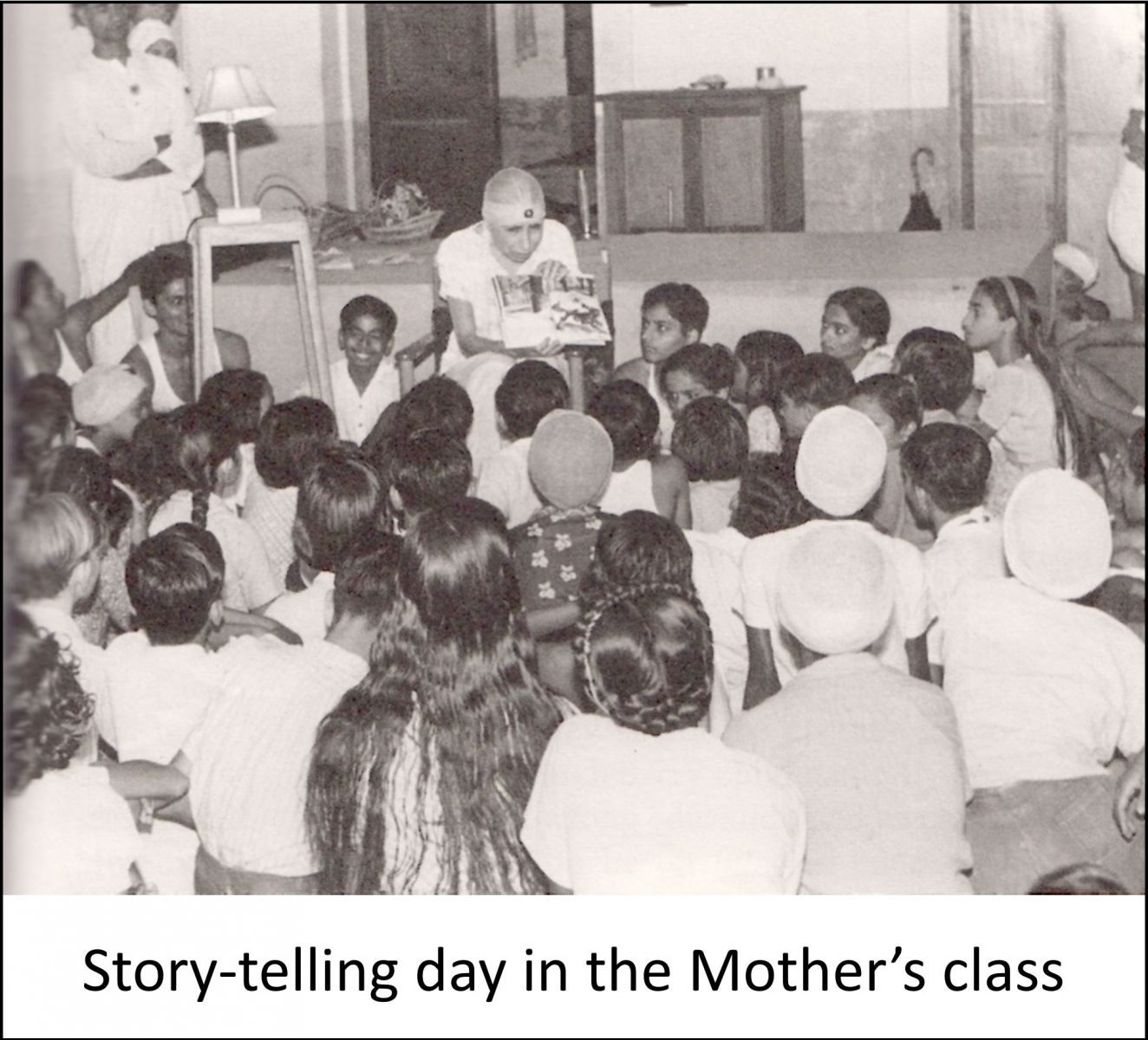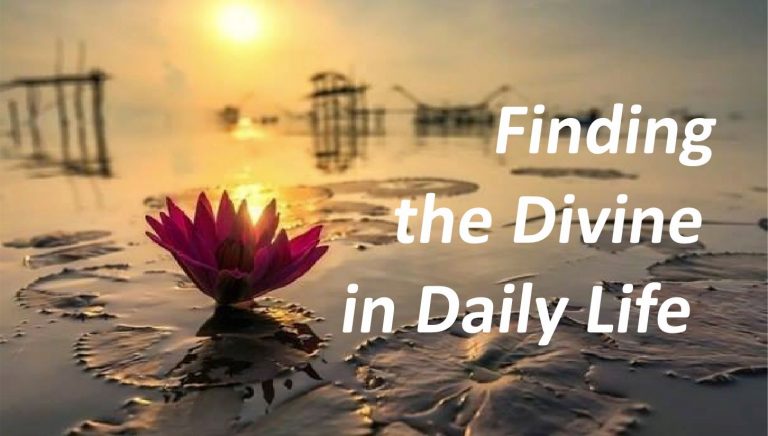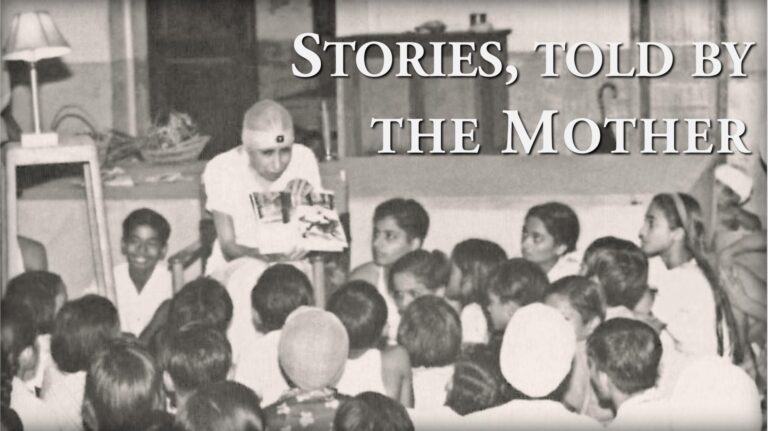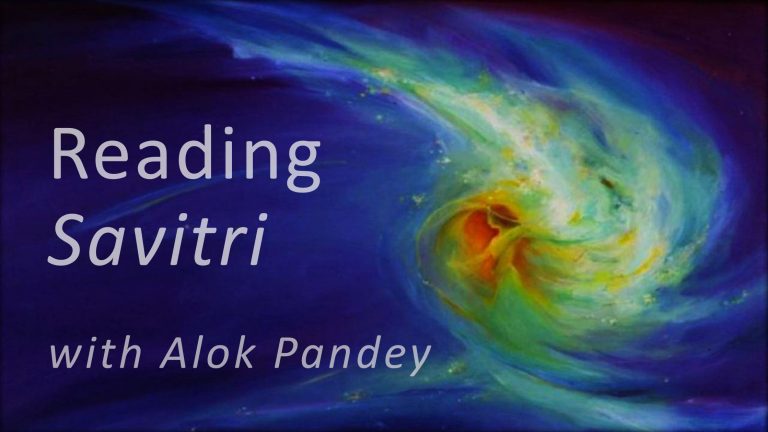Sri Aurobindo had left his body, but not the work for whose achievement he had come on earth. The Mother stood alone now and shouldered the burden with unbroken determination. The following lines in Savitri – they were among the last which Sri Aurobindo dictated – prophetically point towards her new role:
A day may come when she must stand unhelped
On a dangerous brink of the world’s doom and hers,
Carrying the world’s future on her lonely breast,
Carrying the human hope in a heart left sole
To conquer or fail on a last desperate verge.
Alone with death and close to extinction’s edge,
Her single greatness in that last dire scene,
She must cross alone a perilous bridge in Time
And reach an apex of world-destiny…[1]
Even though the Mother was ‘alone’ now in her physical incarnation, the communion with Sri Aurobindo continued on the inner plane: “Sri Aurobindo whom I know and with whom I lived physically for thirty years… has not left me, not for a moment – for He is still with me, day and night, thinking through my brain, writing through my pen, speaking through my mouth and acting through my organising power.”[2] While she was continuing the supramental Yoga on the physical plane, Sri Aurobindo was influencing earth-events from the subtle-physical plane, ‘from the other side’, as it were, free from the limitations of the physical body.
After a twelve days’ break the Mother resumed her activities on 17 December and she increasingly occupied herself with the children now for whom she held special classes on every Tuesday, Friday and Sunday. She gave French lessons, told instructive stories and reported many interesting incidents from her own life. Some children also went to the Mother at other times and were literally enveloped in her love. We may quote from the reminiscences of Tara who belonged to a small group of children that went daily to the Mother: “We used to have a real little ceremony every day. After we had offered our flowers to the Mother, she chose a few of them for each of us, and gave us each a big red tomato. Then we would form a little circle, placing our arms around each other’s shoulders. Promesse stood in the centre of the circle. The Mother drew us towards her until our heads touched and came into contact with hers. Then she would concentrate for a moment before saying ‘Au revoir’ to us.”[3] The youngest member of this group of children was 2½ year old
In June 1951 she started the ‘Wednesday-classes’, at first with no more than seven children. But this group grew quickly and soon there were thirty members. Many Ashram sadhaks also wished now to join the sessions in order to participate in the interesting talks between the Mother and her students. They were allowed to sit behind the circle of the young students. Many joined the group even though they did not understand French. After some time all talks were recorded on tape and published in an Ashram journal. A great part of the Mother’s works is made up of the transcripts of these recordings.
The Ashram School had been started on a small scale on 2 December 1943 and formed a first basis for the educational activities of the Mother. But now the time had come for a far more comprehensive experiment. On 24 April 1951 the Mother announced in a Convention with leading intellectuals and educationalists of the country the foundation of an International University Centre, which was inaugurated on 6 January 1952. In 1959 the ‘Sri Aurobindo International University Centre’ was renamed the ‘Sri Aurobindo International Centre of Education’.
The idea of such an institution had already been expressed by Sri Aurobindo. At the Convention in April 1951 the Mother declared: “Sri Aurobindo is present in our midst, and with all the power of his creative genius he presides over the formation of the University Centre which for years he considered as one of the best means of preparing the future humanity to receive the supramental light that will transform the elite of today into a new race manifesting upon earth the new light and force and life.”[4]
The primary aim of this institution was not to produce brilliant students, but to allow young souls to grow into a higher life through a comprehensive, integral education. It was the teacher’s task to create for every student the necessary conditions for his development and to awaken in him the joy of learning, of discovery. Instead of filling the students with mere book knowledge, they should be encouraged to develop the gift of intuition which every child naturally possesses until it loses it through wrong education and teaching. Moreover, the emphasis was to be on integral education: the Mother made it clear that she did not want pale pattern-pupils. Therefore the daily sports program in the evening is compulsory for all students.
The ideal teacher has, in the Mother’s words, the following qualities:
- Complete self-control not only to the extent of not showing any anger, but remaining absolutely quiet and undisturbed under all circumstances
- In the matter of self-confidence, must also have a sense of the relativity of his importance. Above all, must have the knowledge that the teacher himself must always progress if he wants his students to progress, must not remain satisfied either with what he is or with what he knows.
- Must not have any sense of essential superiority over his students nor preference or attachment whatsoever for one or another.
- Must know that all are equal spiritually and instead of mere tolerance must have a global comprehension or understanding.
- “The business of both parent and teacher is to enable and to help the child to educate himself, to develop his own intellectual, moral, aesthetic and practical capacities and to grow freely as an organic being, not to be kneaded and pressured into form like an inert plastic material.”[5]
The main emphasis in the lessons should not be on factual knowledge, but on the growth of consciousness and the capacity for autonomous self-development:
“Essentially, the only thing you should do assiduously is to teach them to know themselves and choose their own destiny, the path they will follow; to teach them to look at themselves and to will what they want to be. That is infinitely more important than teaching them what happened on earth in former times, or even how the earth is built…”[6]
Of course, whatever knowledge is required for daily life, is also imparted. In fact the standard of education at the International Centre is exceptionally high. The mere fact that all students grow up with four languages speaks for itself. While Sciences are taught in French, Humanities are taught in English. Then there is the mother tongue of the student (that is, mostly an Indian language) and Sanskrit which is compulsory now. Already in the Kindergarten a Sanskrit scholar talks with the children in Sanskrit, using simple words and sentences – it is the nature method. The physical education too is excellent and highly diversified. We have already referred to it. As for the vital being, the children are encouraged to develop qualities such as cheerfulness, sincerity, patience, endurance, equality and fairness.
The Mother has emphasized from the beginning that the International Centre should develop its own methods of teaching and pedagogy. A living relationship between teacher and student, who are ultimately both in the process of learning, is the precondition for such a school of the future. There are no marks and diplomas, which removes considerable obstacles from the atmosphere. However, there are ways by which the student can monitor his own progress objectively. The common mentality of learning for success and career, the habit of swotting and cramming (which is widely spread in India no less than elsewhere), was here to be overcome so that the joy of learning and researching could be fully developed. The classes are kept small and the teachers are Ashram sadhaks who perform this activity as part of their yoga without any remuneration. There are about 150 teachers instructing 500 students up to the B. A. level. Those who want to study at a University outside afterwards, get a statement which has been recognized by some universities in India and in foreign countries. However, several students also decide to stay in Pondicherry as members of the Ashram.
The International Centre is an experiment in the process of growth, a very comprehensive and radical experiment which may still need decades to reach its full potential. The Mother had very high expectations of this institution:
“I am perfectly sure, I am quite confident, there is not the slightest doubt in my mind, that this University, which is being established here, will be the greatest seat of knowledge upon earth.
“It may take fifty years, it may take a hundred years, and you may doubt about my being there; I may be there or not, but these children of mine will be there to carry out my work.
“And those who collaborate in this divine work today will have the joy and pride of having participated in such an exceptional achievement.”[7]
And here once more is her call to the teachers:
“We are not here to do (only a little better) what the others do.
We are here to do what the others cannot do because they do not have the idea that it can be done.
We are here to open the way of the Future to children who belong to the Future.
Anything else is not worth the trouble and not worthy of Sri Aurobindo’s help.”[8]
[1] Savitri (Cent. Ed.), p. 461
[2] Nilima – Glimpses of the Mother’s Life 2:210
[3] Nilima – Glimpses of the Mother’s Life 2:220-21
[4] Nilima – Glimpses of the Mother’s Life 2:227
[5] CWM 12:167
[6] CWM 8:181
[7] Nilima – Glimpses of the Mother’s Life 2:228
[8] Nilima – Glimpses of the Mother’s Life 2:230



